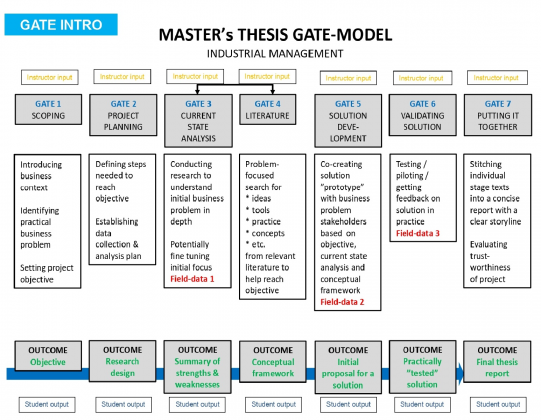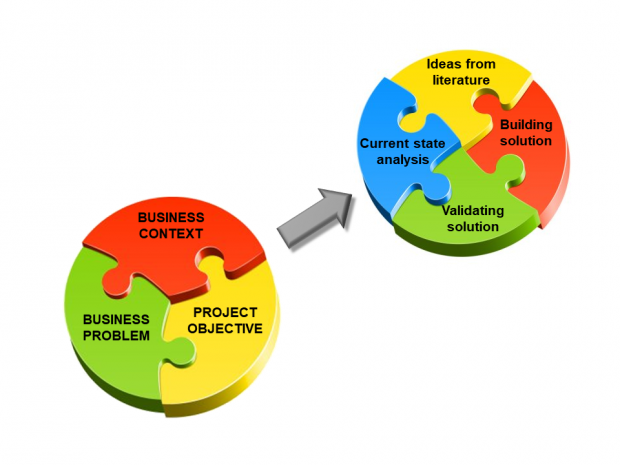Text 2 in this 3-part series of texts focuses on the benefits of the GATE model utilized in Metropolia Industrial Management (IM) Master’s Program for producing the thesis. The model is also used in the IM Bachelor level thesis process. The model centers on a structured thesis process for teaching the methodology and research skills needed for carrying out a business project for a case company and producing the thesis.
The first text dealt with the benefits of the overall degree program, which is designed to make each component work in favor of the students and the projects they have undertaken to complete in one academic year. Text 3 will take a closer look at the specific benefits of one key component of the GATE model, i.e. the Writing Clinics providing one-on-one guidance and using the IM Thesis template as a key tool.
The main aim of this blog series is to share my observations and learnings with instructors interested in adopting scientifically sound, systematic and holistic research and business principles – that produce quality results – into their pedagogical toolbox. Moreover, to quote Dr. Juha Haimala, the Head of IM Degree Program, “the principles are highly applicable to any real business case, not merely higher education Master’s studies.”
Components of GATE Model
The Metropolia IM Master’s thesis is typically a real-life, practical development project carried out for the Master’s student’s employer organization. To tackle the development project, the Master’s Thesis GATE model is based on the idea of dividing the thesis process into 7 well-defined and logical stages called GATES that help the students put together the thesis chapters one by one. The 7 GATEs and their corresponding thesis chapters are shown in Table 1:
Table 1. The seven gates and corresponding thesis chapters.
| Number of Gate | Content of Gate | Corresponding thesis chapter |
| 1 | Scoping | Introduction |
| 2 | Project planning | Methods and Materials |
| 3 | Current State Analysis | Current State Analysis on Case Company Problem x |
| 4 | Literature | Conceptual Framework on Thesis topic x |
| 5 | Solution development | Initial Proposal for Problem x |
| 6 | Validating solution | Validation of Initial Proposal |
| 7 | Putting it together | Conclusions |
The names of the thesis chapters naturally vary somewhat between students but the above provides a middle-of-the-road idea of what the headings of the main chapters could look like. Image 1 further down in the text depicts the entire GATE model in detail, but first a quick reminder is perhaps needed of what an individual Gate is.
GATE = Instructor Input and Student Output
As described briefly in Text 1 of this series, a GATE is a preparation to allow the student to create one key component of the Master’s Thesis at a time, ensuring timely completion. Each of the 7 GATES includes both instructor input and student output and consists of five elements A-E, as illustrated in Table 2:
Table 2. What is a GATE?
| GATE Instructor input A-C | GATE Student output D-E |
|
|
The 7-gate model has its foundation in the Gate model developed originally by Robert Cooper (2008), Professor of marketing, for new product innovation and development. In Cooper’s model new products go through various stages and steps from idea to launch and the ultimate objective is to achieve improved cycle times and commercially successful final products.
For the Master’s Thesis GATE model, the ultimate objective is to help the Master’s students carry out a real-life, highly practical development project for their employer organization that provides evidence-based solutions to enable management level decision making. This is done by following a scientifically sound (see e.g. Reimann, Järvinen 2007) thesis process the outcome of which is the triangulated thesis report that meets Metropolia criteria. Image 1 illustrates in detail the 7 Master’s thesis GATEs, which are explained in detail below the Image.

Image 1. Master’s Thesis 7-Gate Model showing detailed content and outcomes (modified from Rohweder, 2020)
The top row of boxes in Image 1 indicates the Instructor input for each GATE, namely GATE teaching and clinics with one-on-one supervision. The second row of boxes illustrates the GATE names. The white boxes in the middle describe the focus of each GATE and below the white boxes are the outcomes for each GATE. The boxes at the bottom indicate Student output for each GATE, namely GATE presentation and GATE text delivery. The text in red in Image 1 indicates the triangulated data collection points, i.e. data collected at three different stages of the thesis process and (often) from three different sets of stakeholders.
Since the Metropolia IM Master’s thesis is a real-life, practical development project, the idea in GATE 1 is to first introduce the business context and the problem in the employer organization and then formulate the objective for the thesis. This becomes the first chapter of the thesis report: Introduction.
GATE 2 defines the steps needed to reach the objective and describes the data collection and analysis plan, with Research Design as outcome. This becomes chapter 2 of the thesis report: Methods and Material.
As shown by the black arrows in Image 1, the order of GATEs 3 and 4 is interchangeable, depending on what the best approach for solving the thesis problem is. For clarity’s sake, let’s follow the order shown in Image 1. GATE 3 is then the current state analysis where data is collected for the first time, typically through interviews (DATA 1), followed by an in-depth analysis of the situation and problem at hand. As an outcome, the analysis typically reveals both strengths and weaknesses related to the situation. From the weaknesses thus identified, the student typically selects one or several crucial weaknesses for tackling in order to develop a solution. This becomes chapter 3 of the report: Current State Analysis on case company problem x.
GATE 4 is about problem-focused search in relevant literature for ideas, tools and practices to tackle the weaknesses and help reach the objective. The outcome is the conceptual framework, and the thesis chapter is often also called Conceptual Framework on thesis topic x.
GATE 5 is for collecting data for the second time (DATA 2) and for building a co-created initial proposal to tackle the problem, often through workshops in the employer organization. The initial proposal is based on the objective, the strengths and weaknesses revealed by the current state analysis and best practice suggested by relevant literature. The thesis chapter is called Initial Proposal for problem x.
GATE 6 is the third data collection point (DATA 3). Here, the initial proposal is validated, i.e. piloted, tested or feedback is given by for example management-level stakeholders. The outcome is the validated solution, typically with slight fine-tunings to the initial proposal. The corresponding thesis chapter is Validation of Initial Proposal.
GATE 7 is where all the different parts of the report are put together, including abstract, appendices, reference list and such. The last thesis chapter is called Conclusions and it provides an executive summary of the thesis and an evaluation of the trustworthiness of the thesis project.
Once the thesis project and the report is complete, the students give their final GATE presentations, which have been built up ever since the first GATE.
Benefits of GATE model
Text 1 listed many benefits (such as on-time graduation) of the overall degree programme design for all three stakeholders, i.e. Master’s students, Industry and Metropolia. In addition to the benefits mentioned in text 1, we can see the following benefits from utilizing the GATE model:
- Students
- well-defined and logical process that is “easy” to understand and adopt
- clarity of process allows efficient use of time and effort on the actual thesis topic
- clear and consistent tasks that keep building up to the final presentation and the thesis report gate-by-gate
- gate-by-gate supervisor feedback helping to stay on track and sharpen message
- Employer organizations
-
- evidence-based solutions to enable management level decision making
- Faculty
-
- clear roles and responsibilities
- well-defined and logical process that is “easy” to explain
- scientifically sound process that produces positive results
I believe that adding value to each and every class/meeting with the students is the intent of any instructor who is committed to excellence. If this is you, implementing the principles of the GATE model to your professional context is certainly a valuable option as it is easily applicable to other disciplines. Alternatively, can you see this model working in your context slightly modified?
This text provided an in-depth look into the IM Master’s thesis Gate model and its benefits. The last text in this series, Text 3, will follow shortly focusing on the specific benefits of the Writing Clinics providing one-on-one guidance and using the IM Thesis template as a key tool.
References
Cooper, R. (2008). “The Stage-Gate Idea-to-Launch Process–Update, What’s New and NexGen Systems,” in Journal of Product Innovation Management, Volume 25, Number 3, May 2008, pp 213-232
Järvinen, P. (2007). Action research is similar to design science. Quality & Quantity, 41, 37-54.
Reimann, P. (2011). Design-Based Research. Methodological Choice and Design, 37-50.
Rohweder, T. (2020). Applied Research and Development Skills. Gate 1 Teaching slides. Metropolia University of Applied Sciences. Delivered 18 September, 2020.









2 Kommenttia
Sonja,
Rather interesting to delete both my and Zinaida Grabovskaia’s name of a product that was first documented in our Thesis Guide in 2016.
Any particular reason?
Kind regards
Marjatta
I’m very sorry Marjatta, none at all and certainly not intentional. I have cited the sources I was using for this text. I’m sure I can add your names, just tell me the exact place/s and I will. Br, Sonja